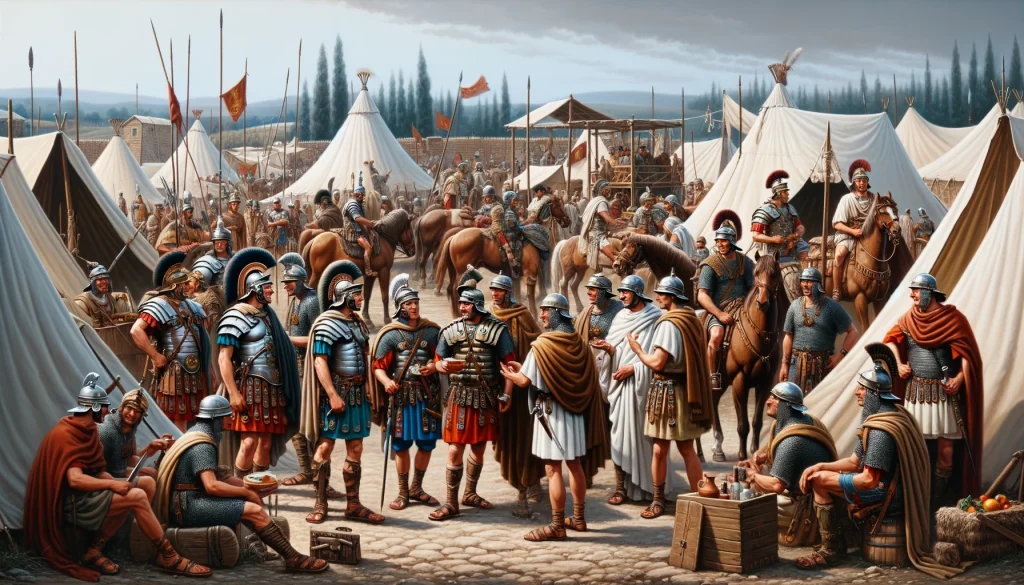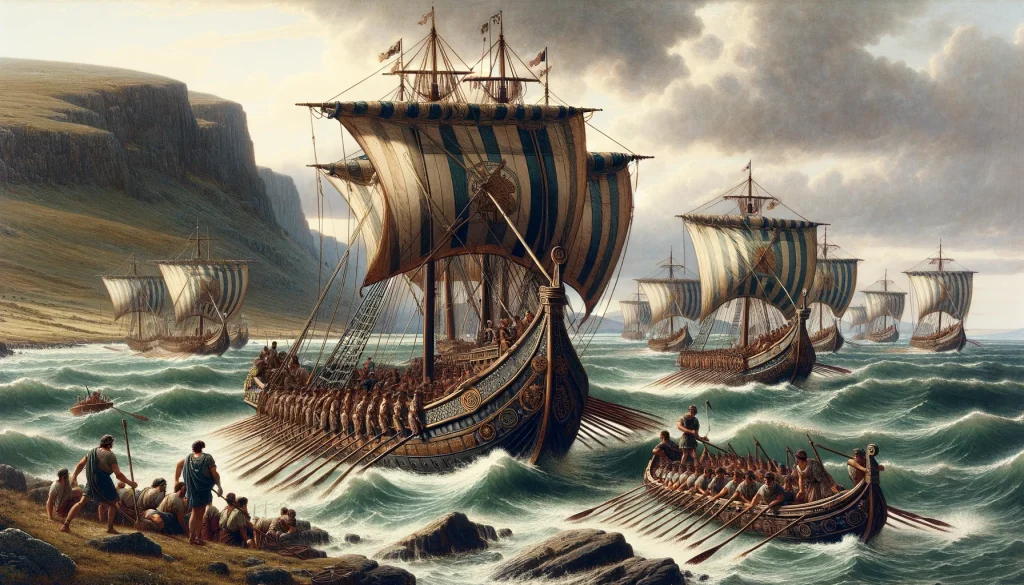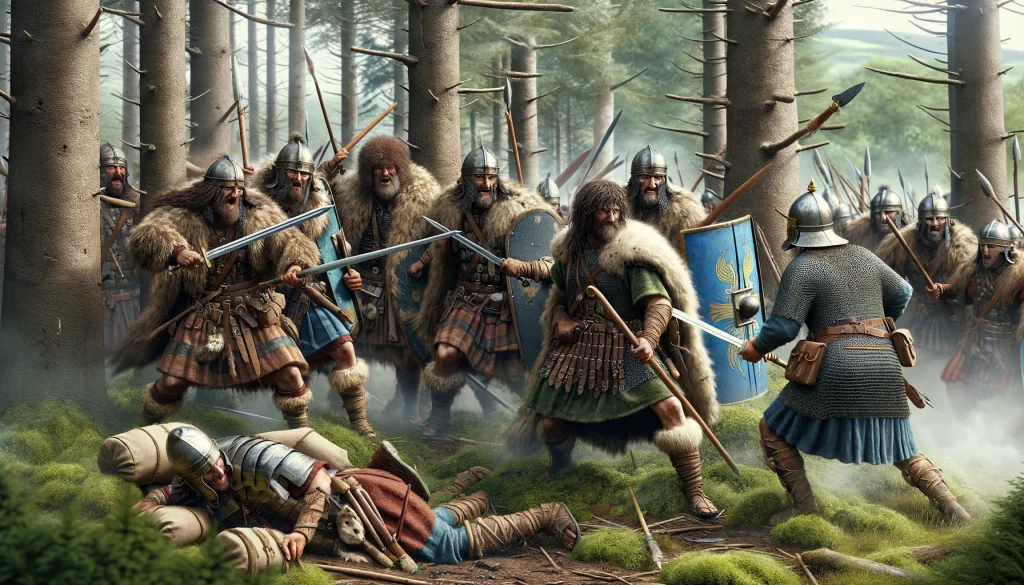Tacitus notes that in the summer marking the start of his sixth year in office, Agricola strategically secured the areas beyond the Forth (Bodotria). Already by his third season (AD 79), Agricola had reached the Tay (Taus), possibly obtaining hostages from the Dumnonii. It seems likely that it was the Dumnonian regions in Stirlingshire and Perthshire that were now strategically encircled with forts, setting the stage for an advance into Caledonia. This timing suggests that the line of forts along the northward road from Camelon, including those at Doune, Ardoch (Alavna Veniconvm), Strageath Fort, and Bertha by the Tay, were established during this period. Positioned at the edge of Dumnonian territory, these forts benefited from the abundant resources of the Fife hinterland. Due to concerns about potential revolts among the tribes beyond the Dumnonii and the risk of disrupted communications by enemy forces, Agricola employed the Classis Britannica in reconnaissance missions. This was the first time the fleet was integrated into his military strategy, impressively aiding the simultaneous land and sea offensive (Tacitus, Agricola, 25.1).

Tacitus proceeds to depict how foot soldiers, cavalry, and sailors frequently intermingled within the same encampment, sharing provisions and jovial exchanges (Agr. 25.1). The origins of the classis Britannica (the British fleet) remain obscure, but this likely marked its initial engagement in real combat. Agricola likely recognized its importance in maintaining communication with his northernmost outpost at Bertha on the River Tay, particularly when the overland route was impassable. Given their journey thus far, it’s inconceivable that the fleet wouldn’t seize the opportunity to extend their exploration northward, beyond Montrose, Stonehaven, and Aberdeen.
Later, Tacitus envisions Calgacus lamenting, “There is no land beyond us, and even the sea offers no safe haven when we are threatened by the Roman fleet” (Agr. 30.1). Calgacus was indeed correct in asserting that Caledonia’s territory extended to the island’s extremity. “There is no nation beyond us, only the ebb and flow of the tides and rugged cliffs” (Agr. 33.1), as the Roman fleet was soon to discover dramatically in the ensuing season.

It’s quite evident that the Britons were astonished by the presence of the fleet, as gleaned from captured individuals, as it seemed that with the revelation of these unknown coastal areas, their last sanctuary for retreat was now closed off (Agr. 25.2). The temporary camp covering 3.2 hectares (8 acres) at Dun, situated on the northern coast of the Montrose basin, likely played a role in these manoeuvres. The discovery of a fragment of Flavian pottery within the ditch supports the overall dating, while the cluster of circular dwellings nearby, ranging from 10 to 15 meters (33 to 50 feet) in diameter, indicates concurrent Caledonian settlement. It appears that the Roman warships had dealt a psychological blow by deploying troops to a previously inaccessible location, one of the enigmatic coastal areas.
Eventually, the inhabitants of Caledonia realized that they had no safe harbour to rely on, no secure sanctuary, and thus they resolved to wage war. Tacitus writes, “The people dwelling in Caledonia resorted to assembling warbands and arming themselves, making grand preparations, exaggerated by hearsay, as is customary when the truth is obscure” (Agr. 25.3). Their initial move was to assault the northernmost forts, prompting some timid advisors in Agricola’s circle to suggest a retreat back to the Forth Estuary.
However, at this juncture, Agricola’s scouts warned of an impending attack by multiple warbands. Tacitus elucidates, “So as not to risk being outflanked by adversaries who outnumbered them and were intimately familiar with the terrain, Agricola divided his army into three divisions and pressed forward” (Agr. 25.4). Such a division into thirds may appear as a curious strategy, possibly even perilous given the uncertain estimation of enemy forces; nonetheless, Agricola’s troops narrowly avoided disaster.

When the enemy found this out, in a sudden change of plan, they advanced together by night against the Ninth Legion, since it was especially weakened. Slaughtering the sentries, they burst in amongst the sleeping and the alarmed. There was already fighting inside the camp when Agricola, who had been
informed of the enemy’s movement by his scouts and was following in their tracks, ordered the swiftest of his cavalry and infantry to attack the rear of the combatants, and presently to raise the battle cry from the whole army.
Tac., Agr. 26.1
Caught between two opposing forces, the Caledonian warband fought their way out of the encampment, despite the congestion at the gateway, and vanished into the cover of night. Meanwhile, the Romans were eager to engage their foes. Tacitus notes, “They urged forward to penetrate into Caledonia and, through a continuous series of skirmishes, ultimately reach the utmost boundary of Britain” (Agr. 27.1). They likely felt the weight of history upon them, with the legendary edge of the world seemingly within grasp.